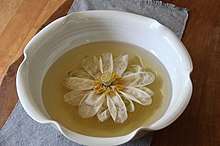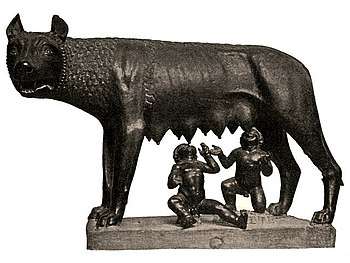Nelumbo nucifera
| Nelumbo nucifera | |
|---|---|
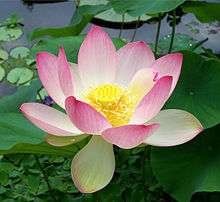 | |
| Scientific classification | |
| Kingdom: | Plantae |
| Clade: | Angiosperms |
| Clade: | Eudicots |
| Order: | Proteales |
| Family: | Nelumbonaceae |
| Genus: | Nelumbo |
| Species: | N. nucifera |
| Binomial name | |
| Nelumbo nucifera | |
| Synonyms | |
Nelumbo nucifera, also known as Indian lotus, sacred lotus, bean of India, Egyptian bean or simply lotus, is one of two extant species of aquatic plant in the family Nelumbonaceae. It is often colloquially called a water lily. Under favorable circumstances the seeds of this aquatic perennial may remain viable for many years, with the oldest recorded lotus germination being from that of seeds 1,300 years old recovered from a dry lakebed in northeastern China.[1]
It has a very wide native distribution, ranging from central and northern India (at altitudes up to 1,400 m or 4,600 ft in the southern Himalayas[2]), through northern Indochina and East Asia (north to the Amur region; the Russian populations have sometimes been referred to as "Nelumbo komarovii"), with isolated locations at the Caspian Sea.[3] Today the species also occurs in southern India, Sri Lanka, virtually all of Southeast Asia, New Guinea and northern and eastern Australia, but this is probably the result of human translocations.[3] It has a very long history (c. 3,000 years) of being cultivated for its edible seeds,[3] and it is commonly cultivated in water gardens.[2] It is the national flower of India and Vietnam.
Classification
The lotus is often confused with the water lilies (Nymphaea, in particular Nymphaea caerulea "blue lotus"). In fact, several older systems, such as the Bentham & Hooker system (which is widely used in the Indian subcontinent) refer to the lotus by its old synonym of Nymphaea nelumbo. This is, however, taxonomically incorrect. Far from being in the same family, Nymphaea and Nelumbo are members of different orders (Nymphaeales and Proteales, respectively).
While all modern plant taxonomy systems agree that this species belongs in the genus Nelumbo, the systems disagree as to which family Nelumbo should be placed in, or whether the genus should belong in its own unique family and order. According to the APG IV system, N. nucifera, N. lutea, and their extinct relatives in Proteales with the protea flowers[4] due to genetic comparisons. Older systems, such as the Cronquist system, place N. nucifera and its relatives in the order Nymphaeles based on anatomical similarities.[5]
Botany

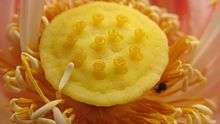
The roots of lotus are planted in the soil of the pond or river bottom, while the leaves float on top of the water surface or are held well above it. The flowers are usually found on thick stems rising several centimeters above the leaves. The plant normally grows up to a height of about 150 cm and a horizontal spread of up to 3 meters, but some unverified reports place the height as high as over 5 meters. The leaves may be as large as 60 cm in diameter, while the showy flowers can be up to 20 cm in diameter.
Researchers report that the lotus has the remarkable ability to regulate the temperature of its flowers to within a narrow range just as humans and other warmblooded animals do.[6] Roger S. Seymour and Paul Schultze-Motel, physiologists at the University of Adelaide in Australia, found that lotus flowers blooming in the Adelaide Botanic Gardens maintained a temperature of 30–35 °C (86–95 °F), even when the air temperature dropped to 10 °C (50 °F). They suspect the flowers may be doing this to attract coldblooded insect pollinators. Studies published in the journals Nature and Philosophical Transactions: Biological Sciences were in 1996 and 1998 important contributions in the field of thermoregulation, heat-producing, in plants. Two other species known to be able to regulate their temperature include Symplocarpus foetidus and Philodendron selloum.
An individual lotus can live for over a thousand years and has the rare ability to revive into activity after stasis. In 1994, a seed from a sacred lotus, dated at roughly 1,300 years old ± 270 years, was successfully germinated.[7][8]
As mentioned earlier, the traditional Sacred Lotus is only distantly related to Nymphaea caerulea, but possesses similar chemistry. Both Nymphaea caerulea and Nelumbo nucifera contain the alkaloids nuciferine and aporphine.
The genome of the sacred lotus was sequenced in May 2013.[9][10][11]
Cultivation
The Sacred Lotus grows in water up to 2.5 m (8 ft). The minimum water depth should not be lower than 30 cm (12 in). In colder climates such a low water level, which heats up more quickly, is helpful for better growth and flowering. Lotus germinates at temperatures above 13 °C (55 °F).[12] Most varieties are not cold-hardy.[13] In the growing season from April to September (northern hemisphere), the average daytime temperature needed is 23 to 27 °C (73 to 81 °F).[14] In regions with low light levels in winter, the sacred lotus has a period of dormancy. The tubers are not cold resistant, but can resist temperatures below 0 °C (32 °F) if they are covered with an insulating cover of water or soil.[15] During winter time, the roots have to be stored at a frost free place.[16][17]
Planting
The sacred lotus requires a nutrient-rich loamy soil.[13] In the beginning of the summer period (from March until May in the northern hemisphere),[18] a small part of rhizome with at least one eye is either planted in ponds[19] or directly into a flooded field.[20][21] There are several other propagation ways via seeds or buds.[15] Furthermore, tissue culture is a promising propagation method for the future to produce high volumes of uniform, true-to-type, disease free materials.[22]
First step of the cultivation is to plough the dry field. One round of manure is applied after ten days, before flooding the field. To support a quick initial growth, the water level is hold relatively low[21] and is increased when plants grow. Then a maximum of approximately 4000 rhizome pieces per hectare (10000 per acre)[22] are used to plant directly into the mud 10–15 cm (3.9–5.9 in) below the soil surface.[23]
Harvest

The stolon is ready to harvest two to three months after planting. It must be harvested before the flowering. Harvesting the stolon is done by manual labour, too. For this step, the field is not drained. By pulling and shaking the young leaves in the shallow water, the stolon is pulled out of the water.[21]
Three months after planting, the first leaves and flowers can be harvested. Flowers can be picked every two days during summer and every three days during the colder season. Four months after planting, the production of flowers has its climax. The harvest of flowers is usually done by hand during three to four months.[21]
Seeds and seed pods can be harvested when they turn black four to eight months after planting. After sun drying for two to three days, they are processed by mechanical tools to separate seed coats and embryos.[21][15]
The rhizomes mature to a suitable stage for eating in approximately six to nine months.[23] Early varieties are harvested in July until September and late varieties from October until March, after the ponds or fields are drained.[15][16][21][23][24] The large, starch rich rhizomes are easy to dig out of the drained soil.[21] In small scale production, they are harvested by hand using fork like tools.[15] In Japan and on bigger farms the manual labour harvesting is fully replaced by machines.[12]
Varieties and cultivars
Lotus varieties have been classified according to their use into three types: rhizome lotus, seed lotus and flower lotus. Varieties that show more than one of these characteristics are classified by the strongest feature.[22] Regarding production area in China, rhizome lotus has the largest area with 200,000 ha (490,000 acres), followed by seed lotus with 20,000 ha (49,000 acres).[25]
Rhizome lotus
Rhizome lotus cultivars produce higher yield of and better quality rhizomes than seed and flower lotus. Furthermore, this group grows the tallest and produces no or very few flowers.[25][22]
Cultivars can be classified by harvest time or by the depth of rhizomes into these types:
- Pre-mature (early) cultivars are harvested before the end of July, serotinous (late) cultivars from September on and mid-serotinous or mid-matutinal cultivars are in between these harvest times. Using pre-mature cultivars, rhizomes can be harvested earlier and therefore be sold for a higher price.[25]
- Ad littoral, deep, and intermediate cultivars are distinguished according to the depth in which the rhizomes grow underground. Adlittoral cultivars range from 10 to 20 cm (3.9 to 7.9 in) depth and are often pre-mature. They develop faster due to higher temperature in surface soil layers. When harvested in July, adlittorals have higher yields than deeper growing cultivars, but not necessarily when harvested in September. Rhizomes of adlittoral cultivars are crisp and good for frying purposes. Deep cultivars grow more than 40 cm (16 in) deep. They are often serotinous and can harvest high yield. Their rhizomes are starch-rich.[25]
The main popular Nelumbo nucifera cultivars in China are Elian 1, Elian 4, Elian 5, 9217, Xin 1 and 00–01. Average yield of these cultivars is 7.5–15 t/ha (3.3-6.7 tons/acre) of harvest in July and 30–45 t/ha (13-20 tons/acre) of harvest in September.[25] In Australia, the cultivar grown for the fresh rhizome market is Quangdong and in Japan the common rhizome cultivars are Tenno and Bitchu.[22]
Seed lotus

The characteristics of seed lotus cultivars are a large number of carpels and seed sets as well as large seeds with better nutritional properties. Roots of these varieties are thin, fibrous and do not form good rhizomes.[22] The main popular cultivars for seed production in China are Cunsanlian, Xianglian 1, Zilian 2, Jianlian, Ganlian 62 and Taikong 36. Average yield of these cultivars in China is 1.05–1.9 t/ha (0.5–0.8 tons/acre) of dry seeds and weight of thousand seeds between 1,020 to 1,800 g (36 to 63 oz).[25] Green Jade and Vietnam-Red are recommended cultivars for seed production in Australia.[22]
Flower lotus
Flower lotus cultivars are used exclusively for ornamental purpose, produce a large number of flowers and the lowest plant height.
[25] Seed production of flower lotus is poor regarding yield and quality. Flower types differ in the number of petals (single petals, double petals or multi-petals) and their colours range from single colour in white, yellow, pink, red to bi-colour, most often of white petals with pink tip or highlights.[22]
Farming
About 70% of lotus for the human consumption is produced in China. In 2005, the cultivation area in China was estimated at 300,000 hectares (740,000 acres).[15] A majority of lotus production takes place in managed farming systems in ponds or flooded fields like rice.[25]
The most widely used system is crop rotation with rice and vegetables. This system is applicable if the propagule (small piece of rhizome) can be planted early in the year. The rhizomes are harvested in July, after which rice can be planted into the same field. Rice is then harvested in October. From November until March, the field stays either free, or a terricolous vegetable such as cabbage or spinach, is planted. Alternatively, the vegetable can also be planted after the harvest of lotus.[25]
Another alternative way is to not harvest the lotus rhizome, although it is ripe. A terricolous vegetable is planted between the rhizomes into the drained field. The rhizomes are then harvested next March.[25]
A third way is to plant lotus in ponds or fields and raise aquatic animals such as fish, shrimp or crab in the same field.[25] A more efficient use of the water for both, the aquatic animal and the lotus production, has been identified with this planting pattern.[26]
Use
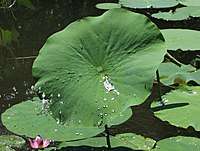
Human consumption
Rhizome consumption
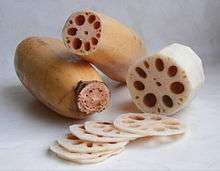

The rhizomes of lotus are called ǒu (藕) in Mandarin, ngau in Cantonese, yeongeun (연근) in Korean, renkon (レンコン, 蓮根) in Japanese, thambou in Meitei, kamal kakri in Hindi, "Behh" in Sindhi and Nelum Ala (නෙළුම් අල) in Sinhalese.
They are consumed as a vegetable in Asian countries, extensively in China and Japan: sold whole or in cut pieces, fresh, frozen, or canned. They are fried or cooked mostly in soups, soaked in syrup or pickled in vinegar (with sugar, chili and garlic).[27][28] Lotus rhizomes have a crunchy texture with sweet-tangy flavours and are a classic dish at many banquets where they are deep-fried, stir-fried, or stuffed with meats or preserved fruits.[27] Salads with prawns, sesame oil or coriander leaves are also popular. Unfortunately, fresh lotus root slices are limited by a fast browning rate.[29][30] Lotus root tea is consumed in Korea.
Japan is one of the primary users of the rhizomes, representing about 1% of all vegetables consumed. Japan grows its own lotus but still must import 18,000 tons of lotus rhizome each year, of which China provides 15,000 tons yearly.[31]
Rhizomes contain high amounts of starch (31.2%) without characteristic taste or odor. The texture is comparable to a raw potato.[32] The binding and disintegration properties of isolated Nelumbo starch have been compared with maize and potato starch; Nelumbo starch is shown to be superior as an adjuvant in the preparation of tablets.[33] When dried, N. nucifera is also made into flour, another popular use of this vegetable.[27][28]
Pip consumption
Lotus pip tea is consumed in Korea.
Seed consumption

Fresh lotus seeds (simplified Chinese: 鲜 莲子; traditional Chinese: 鮮 蓮子; pinyin: xiān liánzĭ; Cantonese Yale: sīn lìhnjí) are nutritious but also vulnerable to microbial contamination, especially fungal infections. Therefore, mostly dry lotus seed-based products are found on the market. Traditional sun baking combining with charcoal processing dries the seeds but results in loss of nutrients. Freeze-dried lotus seeds have a longer shelf life and maintain original nutrients , while no differences in flavour is found after rehydration compared to fresh lotus seeds.[34][35]
Dry stored lotus seeds are sensitive to moisture and mold infestation; researchers continue to explore new ways to preserve fresh lotus seeds for example radiation processing.[36]
Lotus seeds can be processed into moon cake, lotus seed noodles and food in forms of paste, fermented milk, rice wine, ice cream, popcorn (phool makhana) and others, with lotus seeds as the main raw material. Fresh lotus seed wine has thirst quenching, spleen healing and anti-diarrheal advantages after drinking.[37][38] Lotus seed tea is consumed in Korea, and lotus embryo tea is consumed in China and Vietnam.
There is still much potential for research and development, mainly reflected in the extraction, separation and purification of lotus seed nutrients and bioactive compounds.[38]
Stem consumption
Young lotus stems are used as a salad ingredient in Vietnamese cuisine.
In South Indian states, the lotus stem is sliced, marinated with salt to dry, and the dried slices are fried and used as a side dish. In Kerala (in Malayalam "താമര") and Tamil Nadu, this end product is called " Thamara Vathal".
Leaf consumption
In Korea, lotus leaf tea (연잎차 yeonipcha) is made from the leaves of the lotus.
Flower consumption
In Korea, lotus flower tea (연꽃차 yeonkkotcha) is made from the dried petals of the white lotus.
The stamens can be dried and made into a fragrant herbal tea (Chinese: 蓮花 茶; pinyin: liánhuā cha; Cantonese Yale: lìhnfāa chah), or used to impart a scent to tea leaves (particularly in Vietnam). This Vietnamese lotus tea is called trà sen, chè sen, or chè ướp sen.
Risks of consumption
The petals, leaves and rhizome can also all be eaten raw, but there is a risk of parasite transmission (e.g., Fasciolopsis buski): it is therefore recommended that they be cooked before eating.
Use in water treatment
Nelumbo nucifera shows high potential for usage in wastewater treatment removing polluting compounds[39] and heavy metals.[40][41][42] It is able to grow in variable water conditions[43] and in low light intensity.[39] Various studies show the successful use of N. nucifera to counteract water eutrophication.[39][44][45] The leaves of the floating lotus reduce sunlight reaching the lower part of the water. This suppresses algae growth in N. nucifera aquatic systems and thus, the oxygen content is up to 20% higher than in other aquatic plant systems.[39] Due to intense agricultural practices, nitrogen and phosphorus pollution are major problems in aquatic systems. N. nucifera is able to assimilate a higher content of phosphorus than aquatic plants currently used for water remediation (such as water hyacinth). It also assimilates nitrogen ("denitrification") and creates a habitat for bacterial growth in the water body.[39] Through rhizofiltration heavy metals – including arsenic, copper and cadmium – can be removed efficiently from the water.[40][46] The results observed are impressive showing 96% of copper and 85% cadmium metals removed after a seven-day incubation period.[46] The accumulation of heavy metals doesn't show morphological symptoms of metal toxicity;[42] however, the rhizome quality for human consumption needs further study.
Commercialization limit through storage restrictions
Currently most rhizomes are consumed fresh and it is not common to store them due to their poor shelf life performance.[47] This limits export possibilities for low-income production countries in Asia. Rhizomes quickly lose water, oxidation occurs and nutrient composition changes within a short time after harvest. Optimal storage temperatures range between 5 to 8 °C (41 to 46 °F).[47] There are three different approaches to storing rhizomes. By stacking the rhizomes, they are storable and remain fresh for about three weeks. Special stacking with silver sand and soil results in five to six layers that prevent water loss, thus the rhizome stays fresh for up to two months.[47] However the method is not suitable for commercialization but rather for home use. Hydrogen sulfide fumigation reduces enzymatic browning and therefore ensures rhizome quality.[46] Dipping the rhizomes in a salt solution prevents oxidation and bacterial reproduction, which allows storage for up to five months and a greater export ability. This treatment is related to high cost and inefficient cleaning process before eating the rhizomes.[47]
Use in bioengineering
Nelumbo nucifera contains some thermal-stable proteins that might be useful in protein bio engineering processes. The proteins are characterized by seed longevity used for cell protection and repair under stress.[48] There are also several indications that compounds of N. nucifera are used in drug fabrication in human health research for multiple purposes.[49][50]
Other uses
The distinctive dried seed heads, which resemble the spouts of watering cans, are widely sold throughout the world for decorative purposes and for dried flower arranging.
In Asia, the petals are sometimes used for garnish, while the large leaves are used as a wrap for food, not frequently eaten (for example, as a wrapper for zongzi).
A unique fabric from the lotus plant fibers is produced only at Inle lake, Myanmar and in Siem Reap (Cambodia) is used for weaving special robes for Buddha images called kya thingahn (lotus robe).
Chemical composition
The flavonol miquelianin, as well as the alkaloids (+)-(1R)-coclaurine and (−)-(1S)-norcoclaurine, can be found in the leaves of N. nucifera.[51] The plant also contains nuciferine and aporphine.
Health properties and nutrients
Traditional medicine
| Nutritional value per 100 g (3.5 oz) | |
|---|---|
| Energy | 278 kJ (66 kcal) |
|
16.02 g | |
| Sugars | 0.50 g |
| Dietary fiber | 3.1 g |
|
0.07 g | |
|
1.58 g | |
| Vitamins | Quantity %DV† |
| Thiamine (B1) |
11% 0.127 mg |
| Riboflavin (B2) |
1% 0.01 mg |
| Niacin (B3) |
2% 0.3 mg |
| Pantothenic acid (B5) |
6% 0.302 mg |
| Vitamin B6 |
17% 0.218 mg |
| Folate (B9) |
2% 8 μg |
| Choline |
5% 25.4 mg |
| Vitamin C |
33% 27.4 mg |
| Minerals | Quantity %DV† |
| Calcium |
3% 26 mg |
| Iron |
7% 0.9 mg |
| Magnesium |
6% 22 mg |
| Manganese |
10% 0.22 mg |
| Phosphorus |
11% 78 mg |
| Potassium |
8% 363 mg |
| Sodium |
3% 45 mg |
| Zinc |
3% 0.33 mg |
| Other constituents | Quantity |
| Water | 81.42 g |
|
| |
| |
|
†Percentages are roughly approximated using US recommendations for adults. Source: USDA Nutrient Database | |
All parts of Nelumbo nucifera are edible, with the rhizome and seeds being the main consumption parts. Traditionally rhizomes, leaves, and seeds have been used as folk medicines, Ayurveda, Chinese traditional medicine, and oriental medicine.[52][53] While leaves are used for hematemesis, epistaxis, and hematuria, the flowers are used for diarrhea, cholera, fever, and hyperdipsia.[52][53] Rhizomes are promoted have purported diuretic, antidiabetic, and anti-inflammatory properties.[52][53][54][55] In Chinese medicine, seeds are still used as Lian Zi Xi.[56]
Lotus rhizomes and seeds and their processing by-products are widely consumed in Asia, Americas, and Oceania for high content of physiologically active substances.[55] Especially in China, lotus seeds are popular with a cultural history going back about 3000 years. As early as the Han Dinasty, lotus seeds were already recorded as sweet, astringent, nourishing the heart and kidney in "Shen Nong's Herbal Classic".[57] Nowadays there are 22 varieties for the four known Chinese lines, which are found particularly in Jianning (still called "the town of Jianlian lotus seeds in China") and Guangchang ("the town of white lotus seeds in China").[58]
These days the perennial aquatic herb is gaining popularity because of its nutraceutical and historical importance[55][38] It will be of economic value if the different parts of lotus can be developed as functional food.[53][38] Because of the special role in human health and richness in nutrients and bioactive substances, the Chinese Ministry of Health approved the use of N. nucifera as both "food and medicine".[59]
Rhizomes
The rhizomes are 60–14 cm (23.6–5.5 in) long, 0.5–2.5 cm (0.20–0.98 in) in diameter, yellowish white to yellowish brown, smooth and with nodes and internodes.[60]
The lotus root is used to add seasoning to food. Lotus root is a moderate calorie root vegetable (100 g of root-stem provides about 74 calories) and is composed of several vitamins, minerals, and nutrients: 83.80% water, 0.11% fat, 1.56% reducing sugar, 0.41% sucrose, 2.70% crude protein, 9.25% starch, 0.80% fiber, 0.10% ash and 0.06% calcium.[61] 100 g of root provides 44 mg of vitamin C or 73% of daily recommended values (RDA).
Lotus rhizome and its extracts have shown diuretic, psychopharmacological, anti-diabetic, anti-obesity, hypoglycemic, antipyretic and antioxidant activities.[62][63][64][65][66][67]
Seeds
Lotus seeds are mostly oval or spherical, with sizes varying according to varieties. They are generally 1.2–1.8 cm long, with diameter ranging from 0.8 to 1.4 cm and a weight of 1.1–1.4 g. After lotus seeds have been decorticated and peeled, they are edible and rich in nutrients, and can be dried for storage. Their nutritional values can differ due to culture environments and varieties.[68]
Not only do these seeds contain proteins of high quality and are rich in variety of essential amino acids including high contents of albumin (42%) and globulin (27%), they also contain unsaturated fatty acids, carbohydrates, vitamins, calcium, iron, zinc, phosphorus and other trace elements.[69][70] They also provide water-soluble polysaccharides, alkaloids, flavonoids, superoxide dismutase and other bioactive components.[71]
Lotus seed also contain particularly large amounts of vitamins, including VB1, VB2, VB6 and Vitamin E.[72][73]
The functional components (polyphenols, protein, polysaccharides) in N. nucifera seeds can help combatting high blood pressure, diabetes and gallstones.[37] Lotus seed's water-soluble polysaccharides have also been shown to promote lymphocyte transformation and enhance the immune function.[74]
After lotus seed germination, crude protein and fat levels in the endosperm significantly increase. It is therefore an important method to enhance its nutritional quality.[75][38]
Cultural significance



Nelumbo nucifera is the species of lotus sacred to both Hindus and Buddhists.[76]
Hindus revere it with the divinities Vishnu and Lakshmi often portrayed on a pink lotus in iconography. In the representation of Vishnu as Padmanabha (Lotus navel), a lotus issues from his navel with Brahma on it. The goddess Saraswati is portrayed on a white-colored lotus. The lotus is the symbol of what is divine or immortality in humanity, and is also a symbol of divine perfection. The lotus is the attribute of sun and fire gods. It symbolizes the realization of inner potential and in Tantric and Yogic traditions the lotus symbolizes the potential of an individual to harness the flow of energy moving through the chakras ( often depicted as wheel like lotuses) flowering as the thousand -petaled lotus of enlightenment at the top of the skull. [77]
Often used as an example of divine beauty, Vishnu is often described as the "Lotus-Eyed One". Its unfolding petals suggest the expansion of the soul. The growth of its pure beauty from the mud of its origin holds a benign spiritual promise. In Hindu iconography, other deities, like Ganga and Ganesha are often depicted with lotus flowers as their seats.
The lotus plant is cited extensively within Puranic and Vedic literature, for example:
One who performs his duty without attachment, surrendering the results unto the Supreme Lord, is unaffected by sinful action, as the lotus is untouched by water.
— Bhagavad Gita 5.10:
In Chinese culture, Confucian scholar Zhou Dunyi wrote:
I love the lotus because while growing from mud, it is unstained.
The lotus is also representative of Macau, and its flag features said flower.
Many deities of Asian religions are depicted as seated on a lotus flower. In Buddhist symbolism, the lotus represents purity of the body, speech and mind, as if floating above the murky waters of material attachment and physical desire. According to legend, Gautama Buddha was born with the ability to walk with lotus flowers blooming everywhere he stepped. In Tibet, Padmasambhava, the Lotus-Born, is considered the Second Buddha, having brought Buddhism to that country by conquering or converting local deities. In Christianity, the St. Thomas Cross features a lotus being at the base of the cross.
In the classical written and oral literature of many Asian cultures the lotus is present in figurative form, representing elegance, beauty, perfection, purity and grace, being often used in poems and songs as an allegory for ideal feminine attributes. In Sanskrit the word lotus (padma पद्म) has many synonyms.
Since the lotus thrives on water, ja (denoting birth) is added to synonyms of water to derive some synonyms for the lotus, like rajiv, ambuja (ambu= water + ja=born of), neerja (neera=water + ja= born of), pankaj, pankaja, kamal, kamala, kunala, aravind, arvind, nalin,nalini and saroja[79] and names derived from the lotus, like padmavati (possessing lotuses) or padmini (full of lotuses).[80] These names and derived versions are often used to name girls, and to a lesser extent boys, in India, Nepal, Bangladesh and Sri Lanka, as well as in many other nations influenced by Indic culture, like Thailand, Laos, Cambodia, Indonesia and Malaysia.
Drawing in turn on these beliefs, the international Bahá'í community adopted this symbolism in the design of the Lotus Temple in New Delhi, India.
The lotus flower is also the state flower of several Indian states, including Karnataka, Haryana, and Andhra Pradesh.[81]
Gallery
 Lotus field
Lotus field Fruit of Nelumbo nucifera; the dried seed cup is commonly used in flower arrangements.
Fruit of Nelumbo nucifera; the dried seed cup is commonly used in flower arrangements. Bud of Nelumbo nucifera
Bud of Nelumbo nucifera Lotus fruit at Mendut monastery, Indonesia
Lotus fruit at Mendut monastery, Indonesia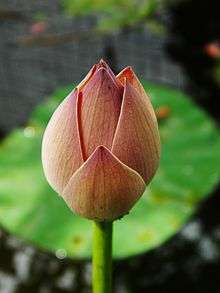 Bud of Nelumbo nucifera
Bud of Nelumbo nucifera Lotus bud at Mendut monastery, Indonesia
Lotus bud at Mendut monastery, Indonesia Blooming Nelumbo nucifera
Blooming Nelumbo nucifera Lotus flower at Mendut monastery, Indonesia
Lotus flower at Mendut monastery, Indonesia
See also
References
- ↑ Shen-Miller, J.; Schopf, J. W.; Harbottle, G.; Cao, R.-j.; Ouyang, S.; Zhou, K.-s.; Southon, J. R.; Liu, G.-h. (2002). "Long-living lotus: Germination and soil -irradiation of centuries-old fruits, and cultivation, growth, and phenotypic abnormalities of offspring". American Journal of Botany. 89 (2): 236–47. doi:10.3732/ajb.89.2.236. PMID 21669732.
- 1 2 Pulok K. Mukherjee; Debajyoti Mukherjee; Amal K. Maji; S. Rai; Michael Heinrich (2010). "The sacred lotus (Nelumbo nucifera)– phytochemical and therapeutic profile". Journal of Pharmacy and Pharmacology. 61 (4): 407–422. doi:10.1211/jpp.61.04.0001.
- 1 2 3 Yi Zhang; Xu Lu; Shaoxiao Zeng; Xuhui Huang; Zebin Guo; Yafeng Zheng; Yuting Tian; Baodong Zheng (2015). "Nutritional composition, physiological functions and processing of lotus (Nelumbo nucifera Gaertn.) seeds: a review". Phytochem Rev. 14 (3): 321–334. doi:10.1007/s11101-015-9401-9.
- ↑ Angiosperm Phylogeny Group (2016). "An update of the Angiosperm Phylogeny Group classification for the orders and families of flowering plants: APG IV" (PDF). Botanical Journal of the Linnean Society. 181 (1): 1–20. doi:10.1111/boj.12385. ISSN 0024-4074.
- ↑ Texas A and M University Bioinformatics Working Group : Cronquist System
- ↑ Yoon, Carol Kaesuk (1996-10-01). "Heat of Lotus Attracts Insects And Scientists". New York Times. Retrieved 2012-11-14.
- ↑ Shen-Miller; Mudgett, M. B.; William Schopf, J.; Clarke, S.; Berger, R.; et al. (1995). "Exceptional seed longevity and robust growth: Ancient sacred lotus from China". American Journal of Botany. 82 (11): 1367–1380. doi:10.2307/2445863. JSTOR 2445863.
- ↑ Shen-Miller, J. (2002). "Long-living lotus: germination and soil gamma-irradiation of centuries-old fruits, and cultivation, growth, and phenotypic abnormalities of offspring". American Journal of Botany. 89 (2): 236–247. doi:10.3732/ajb.89.2.236. PMID 21669732.
Sacred lotus (Nelumbo nucifera) has been cultivated as a crop in Asia for thousands of years. An ≈1300-yr-old lotus fruit, recovered from an originally cultivated but now dry lakebed in northeastern China, is the oldest germinated and directly 14C-dated fruit known. In 1996, we traveled to the dry lake at Xipaozi Village, China, the source of the old viable fruits.
- ↑ Ming, Ray; VanBuren, Robert; Liu, Yanling; Yang, Mei; Han, Yuepeng; et al. (2013). "Genome of the long-living sacred lotus (Nelumbo nucifera Gaertn.)". Genome Biology. 14 (5): R41. doi:10.1186/gb-2013-14-5-r41. PMC 4053705. PMID 23663246.
- ↑ "Sacred Lotus Genome Sequence Enlightens Scientists". Science Daily. 10 May 2013. Retrieved 13 May 2013.
- ↑ Wolpert, Stuart (10 May 2013). "Scientists sequence genome of 'sacred lotus,' which likely holds anti-aging secrets". UCLA Newsroom. Retrieved 13 May 2013.
- 1 2 Sou, S. Y.; Fujishige, N. (1995). "Cultivation comparison of lotus (Nelumbo nucifera) between China and Japan". J. Zhejiang Agr. Sci. 4: 187–189.
- 1 2 Dictionary of gardening. Huxley, Anthony, 1920-1992., Griffiths, Mark, 1963-, Royal Horticultural Society (Great Britain). London: Macmillan Press. 1992. ISBN 978-0333474945. OCLC 25202760.
- ↑ 1932-, Phillips, Roger, (1995). Vegetables. Rix, Martyn. London: Macmillan. ISBN 978-0333626405. OCLC 32465255.
- 1 2 3 4 5 6 Tian, Daike (2008). Container production and post-harvest handling of Lotus (Nelumbo) and Micropropagation of herbaceous Peony (Paeonia). Auburn: Auburn University.
- 1 2 MASUDA, JUN-ICHIRO; URAKAWA, TOSHIHIRO; OZAKI, YUKIO; OKUBO, HIROSHI (2006-01-01). "Short Photoperiod Induces Dormancy in Lotus (Nelumbo nucifera)". Annals of Botany. 97 (1): 39–45. doi:10.1093/aob/mcj008. ISSN 0305-7364. PMC 2000761. PMID 16287906.
- ↑ "Nelumbo nucifera Gaertn. | Plants of the World Online | Kew Science". powo.science.kew.org. Retrieved 2017-11-19.
- ↑ Tian, Daike; Tilt, Ken M.; Sibley, Jeff L.; Woods, Floyd M.; Dane, Fenny (2009-06-01). "Response of Lotus (Nelumbo nucifera Gaertn.) to Planting Time and Disbudding". HortScience. 44 (3): 656–659. ISSN 0018-5345.
- ↑ Flowering plants, dicotyledons : magnoliid, hamamelid, and caryophyllid families. Kubitzki, Klaus, 1933-, Rohwer, J. G. (Jens G.), 1958-, Bittrich, V. (Volker), 1954-. Berlin. ISBN 9783642081415. OCLC 861705944.
- ↑ Lim, T. K. (2016). "Nelumbo nucifera". Edible Medicinal and Non-Medicinal Plants. Springer, Cham. pp. 55–109. doi:10.1007/978-3-319-26062-4_5. ISBN 9783319260617.
- 1 2 3 4 5 6 7 La-ongsri, Woranuch; Trisonthi, Chusie; Balslev, Henrik (2009-08-01). "Management and use of Nelumbo nucifera Gaertn. in Thai wetlands". Wetlands Ecology and Management. 17 (4): 279–289. doi:10.1007/s11273-008-9106-6. ISSN 0923-4861.
- 1 2 3 4 5 6 7 8 V., Nguyen, Q. (2001). Exporting lotus to Asia : an agronomic and physiological study : a report for the Rural Industries Research and Development Corporation. Hicks, D., Rural Industries Research and Development Corporation (Australia). Asian Foods Research and Development. Barton, A.C.T.: RIRDC. ISBN 978-0642582546. OCLC 52647644.
- 1 2 3 E.), Kay, D. E. (Daisy (1987). Root crops. Tropical Development and Research Institute (Great Britain) (2nd ed.). London: Tropical Development and Research Institute. ISBN 978-0859542005. OCLC 19298279.
- ↑ Deni., Bown, (1995). Encyclopedia of herbs & their uses. Herb Society of America. (1st American ed.). London: Dorling Kindersley. ISBN 978-0789401847. OCLC 32166152.
- 1 2 3 4 5 6 7 8 9 10 11 Guo, H. B. (2009-05-01). "Cultivation of lotus (Nelumbo nucifera Gaertn. ssp. nucifera) and its utilization in China". Genetic Resources and Crop Evolution. 56 (3): 323–330. doi:10.1007/s10722-008-9366-2. ISSN 0925-9864.
- ↑ Assessing lotus for wastewater bioremediation. Seymour, Evizel., Rural Industries Research and Development Corporation (Australia). Canberra: Rural Industries Research and Development Corp. 2009. ISBN 978-1741518887. OCLC 682913738.
- 1 2 3 YU, Xin, et al. "Progress in the Research on Post-harvest Physiology and Storage Techniques of Nelumbo nucifera gaertn [J]." Guangzhou Food Science and Technology 3 (2002): 019.
- 1 2 Tian, N., et al. "Isolation and preparation of flavonoids from the leaves of Nelumbo nucifera Gaertn by preparative reversed-phase high performance liquid chromatography." Se pu= Chinese journal of chromatography 25.1 (2007): 88-92.
- ↑ X. Su, Y. Jiang, Y. Li, W. Lin. Effects of 4-hexylresorcinol (4-HR) on browning and quality of fresh-cut lotus. Food Science, 24 (2003), pp. 142-145
- ↑ M.A. Rojas-Graüa, M.S. Tapiab, O. Martín-Bellosoa. Using polysaccharide-based edible coatings to maintain quality of fresh-cut Fuji apples. LWT Food Science and Technology, 41 (2008), pp. 139-147
- ↑ Tsuchiya, T., and Nohara, S. 1989. Growth and life span of the leaves of Nelumbo nucifera Gaertn. in lake Kasumigaura, Japan. Aquatic botany, 36(1): 87-95
- ↑ Mukherjee PK. et al. Isolation, estimation and characterization of starch from rhizomes of Nelumbo nuciferaGaertn (Fam. Nymphaeaceae). Ind Drugs 1995; 32: 392–397.
- ↑ Mukherjee PK. et al. Pharmaceutical application of starch isolated from Nelumbo nucifera Gaertn. (Fam. Nymphaeaceae). Ind J Pharm Sci 1996; 58: 59–66.
- ↑ He J, Cheng W, Chen X, Wen S, Zhang G, Xiong G, Ye L, Chen Y (2006) Study on the vacuum sublimation freezing-drying of lotus seeds. Hubei Agric Sci 45:240–244
- ↑ Tian Y, Zhang Y, Zeng S, Zheng Y, Chen F, Guo Z, Lin Y, Zheng B (2012b) Optimization of microwave vacuum drying of lotus (Nelumbo nucifera Gaertn.) seeds by response surface methodology. Food Sci Technol Int 18:477–488
- ↑ Bhat, R; Sridhar, KR; Karim, AA; Young, CC; Arun, AB (2009). "Influence of c-radiation on the nutritional and functional qualities of lotus seed flour". J Agric Food Chem. 57 (20): 9524–9531. doi:10.1021/jf902287e. PMID 19778060.
- 1 2 Wu C, Xia Y, Tang X (2013) Optimization of fermentation process for lotus rice-wine production by response surface methodology. Mod Food Sci Technol 29:1675–1679
- 1 2 3 4 5 Zhang, Yi; Lu, Xu; Zeng, Shaoxiao; Huang, Xuhui; Guo, Zebin; Zheng, Yafeng; Tian, Yuting; Zheng, Baodong (2015). "Nutritional composition, physiological functions and processing of lotus (Nelumbo nucifera Gaertn.) seeds: A review". Phytochemistry Reviews. 14 (3): 321. doi:10.1007/s11101-015-9401-9.
- 1 2 3 4 5 Thongchai Kanabkaew; Udomphon Puetpaiboon (2004). "Aquatic plants for domestic wastewater Treatment: Lotus (Nelumbo nucifera) and Hydrilla (Hydrilla verticillata) systems" (PDF). Songklanakarin J. Sci. Technol. 26.
- 1 2 H.M. Anawar; A. Garcia-Sanchez; M. Tari Kul Alam; M. Majibur Rahman (2008). "Phytofiltration of water polluted with arsenic and heavy metals". International Journal of Environment and Pollution. 33. doi:10.1504/IJEP.2008.0194 (inactive 2018-09-11).
- ↑ Virendra Mishra (2009). "Accumulation of Cadmium and Copper from Aqueous Solutions using Indian Lotus (Nelumbo nucifera)". AMBIO : A Journal of the Human Environment. 38 (2): 110–112. doi:10.1579/0044-7447-38.2.110.
- 1 2 Gallego, S. M.; M. P. Benavides; M. L. Tomaro (1996). "Effect of heavy metal ion excess on sunflower leaves: evidence for involvement of oxidative stress". Plant Sci.(Shannon). 121 (2): 151–159. doi:10.1016/s0168-9452(96)04528-1.
- ↑ "Lotus care sheet".
- ↑ Othman, Rashidi (2014). "Aquatic plants as ecological indicator for urban lakes eutrophication status and indices". International Journal of Sustainable Energy and Environment Research. 3: 178–184.
- ↑ Liu, C.-Q. (December 2013). "Ecological restoration using Trapa bispinosa and Nelumbo nucifera on eutrophic water body in Baizangdian Lake". researchgate.
- 1 2 3 Virendra Mishra (2009). "Accumulation of Cadmium and Copper from Aqueous Solutions using Indian Lotus (Nelumbo nucifera)". AMBIO: A Journal of the Human Environment. 38 (2): 110–112. doi:10.1579/0044-7447-38.2.110.
- 1 2 3 4 H.B. Guo (2009). "Cultivation of Lotus (Nelumbo nucifera Gaertn. spp. nucifera) and ist utilization in China". Genet Resour Crop Evol. 56 (3): 323–330. doi:10.1007/s10722-008-9366-2.
- ↑ Shen-Miller, J.; Lindner, Petra; Xie, Yongming; Villa, Sarah; Wooding, Kerry; Clarke, Steven G.; Loo, Rachel R. O.; Loo, Joseph A. (2013-09-01). "Thermal-stable proteins of fruit of long-living Sacred Lotus Nelumbo nucifera Gaertn var. China Antique". Tropical Plant Biology. 6 (2–3): 69. doi:10.1007/s12042-013-9124-2. ISSN 1935-9756. PMC 3869599. PMID 24363819.
- ↑ Zi Xi, Lian (2011). "Neferine inhibits cultured hepatic stellate cell activation and facilitates apoptosis: a possible molecular mechanism". Eur. J. Pharmacol. 650 (1): 163–169. doi:10.1016/j.ejphar.2010.10.025. PMID 20969858.
- ↑ Wu and Xiao (2013). Missing or empty
|title=(help) - ↑ Kashiwada, Y.; Aoshima, A.; Ikeshiro, Y.; Chen, Y. P.; Furukawa, H.; Itoigawa, M.; Fujioka, T.; Mihashi, K.; Cosentino, L. M.; Morris-Natschke, S. L.; Lee, K. H. (2005). "Anti-HIV benzylisoquinoline alkaloids and flavonoids from the leaves of Nelumbo nucifera, and structure–activity correlations with related alkaloids". Bioorganic & Medicinal Chemistry. 13 (2): 443–448. doi:10.1016/j.bmc.2004.10.020. PMID 15598565.
- 1 2 3 Khare CP. Indian Herbal Remedies: Rational Western Therapy, Ayurvedic, and Other Traditional Usage, Botany, 1st edn. USA: Springer, 2004: 326–327.
- 1 2 3 4 Sridhar KR, Bhat R. Lotus: a potential nutraceutical source. J Agri Technol 2007; 3: 143–155.
- ↑ Mukherjee, Pulok K; Pal, M; Saha, Kakali; Saha, B. P; Das, J (1996). "Diuretic Activity of Extract of the Rhizomes of Nelumbo nucifera Gaertn. (Fam. Nymphaeaceae)". Phytotherapy Research. 10 (5): 424. doi:10.1002/(SICI)1099-1573(199608)10:5<424::AID-PTR857>3.0.CO;2-3.
- 1 2 3 Mukherjee, Pulok K; Mukherjee, Debajyoti; Maji, Amal K; Rai, S; Heinrich, Michael (2009). "The sacred lotus(Nelumbo nucifera)- phytochemical and therapeutic profile". Journal of Pharmacy and Pharmacology. 61 (4): 407–22. doi:10.1211/jpp.61.04.0001. PMID 19298686.
- ↑ Ding H, et al. Neferine inhibits cultured hepatic stellate cell activation and facilitates apoptosis: A possible molecular mechanism. Eur J Pharmacol. (2011)
- ↑ Li Z (2008) Nutrient value and processing of lotus seed. Acad Period Agric Prod Process 2008:42–43
- ↑ Zheng B, Zheng J, Zeng S (2003) Analysis of the nutritional compositionin chinese main lotus seed varieties. Acta Nutr Sin 25:153–156
- ↑ Evaluation of the quality of lotus seed of Nelumbo nuciferaGaertn from outer space mutationJin-ZhongWu, Yuan-Bin Zheng, Ti-QiangChen, JunYi, Lu-PingQin, KhalidRahman, Wen-XiongLin, (2007) Volume 105, Issue 2, 2007, Pages 540-547
- ↑ Mukherjee PK. et al. Pharmacognostical profiles of rhizomes of Nelumbo nucifera Gaertn. Ancient Sci Life 1998; 17: 273–279.
- ↑ Mukherjee PK et al. Antipyretic activity of Nelumbo nucifera rhizome extract. Ind J Exp Biol 1996; 34: 275– 276
- ↑ Mukherjee, PK; Das, J; Saha, K; Pal, M; Saha, BP (1996). "Diuretic activity of the rhizomes of Nelumbo nucifera Gaertn (Fam. Nymphaeaceae)". Phytother Res. 10 (5): 424–425. doi:10.1002/(sici)1099-1573(199608)10:5<424::aid-ptr857>3.3.co;2-v.
- ↑ Mukherjee, PK; Saha, K; Balasubramanian, R; Pal, M; Saha, BP (1996). "Studies on psychopharmacological effects of Nelumbo nucifera Gaertn. Rhizome extract". J Ethnopharmacol. 54 (2): 63–67. doi:10.1016/s0378-8741(96)01455-9.
- ↑ Mukherjee, K; Saha, K; Pal, M; Saha, B (1997). "Effect of Nelumbo nucifera rhizome extract on blood sugar level in rats". Journal of Ethnopharmacology. 58 (207–213): 32. doi:10.1016/s0378-8741(97)00107-4.
- ↑ Huralikuppi, JC; Christopher, AB; Stephen, P (1991). "Antidiabetic effect of Nelumbo nucifera (Gaertn): Part I Preliminary studies in rabbits". Phytother Res. 5 (2): 54–58. doi:10.1002/ptr.2650050203.
- ↑ Mukherjee PK, Das J, Saha K, Giri SN, Pal M, Saha BP. Antipyretic activity of Nelumbo nucifera rhizome extract. Ind J Exp Biol 1996; 34(3):275-276. 35
- ↑ Rakesh, PD; Sekar, S; Kumar, KLS (2011). "A comparative study on the antidiabetic effect of Nelumbo nucifera and glimepiride in streptozotocin induced diabetic rats". International Journal of Pharma and Bio Sciences. 2: 2.
- ↑ Wang, J; Zhang, G (2010). "The yield and chemical composition of lotus seed on different culture conditions". Hubei J TCM. 32: 75–76.
- ↑ Shad MA, Nawaz H, Siddique F, Zahra J, Mushtaq A (2013) Nutritional and functional characterization of seed kernel of lotus (Nelumbo nucifera): application of response surface methodology. Food Sci Technol Res 19:163–172
- ↑ Tang P, Jiang Z, Mei C, Jiang H (1998) The composition, solubility and quality of lotus seed. J Beijing Norm Univ (Nat Sci) 34:532–537
- ↑ Zheng B, Zheng J, Zeng C (2004) Study on three functional components of Chinese main lotus seed varieties. Acta Nutr Sin 26:158–160
- ↑ Zheng B, Zheng J, Zeng S (2003) Analysis of the nutritional composition in Chinese main lotus seed varieties. Acta Nutr Sin 25:153–156
- ↑ Wu J, Zheng Y, Chen T, Yi J, Qin L, Rahman K, Lin W (2007) Evaluation of the quality of lotus seed of Nelumbo nucifera Gaertn. from outer space mutation. Food Chem 105:540–547
- ↑ Sung J, Sung J, Shin H (2011) Cytoprotective effects of lotus (Nelumbo nucifera Gaertner) seed extracts on oxidative damaged mouse embryonic fibroblast cell. Food Sci Biotechnol 20:1533–1537
- ↑ Xia Y (2012) Effect of germination on chemical and functional properties of lotus seeds. Food Sci 33:91–98
- ↑ "Nelumbo nucifera (sacred lotus)". Kew. Retrieved 26 July 2015.
- ↑ Tresidder, Jack (1997). THe Hutchinson Dictionary of Symbols. London: Duncan Baird Publishers. p. 126. ISBN 978-1-85986-059-5.
- ↑ "周敦颐:《爱莲说》". Book.qq.com. Archived from the original on 2012-04-25. Retrieved 2012-11-14.
- ↑ Indian baby names Archived 2010-12-02 at the Wayback Machine.. pitarau.com
- ↑ Sanskrit-based names. behindthename.com
- ↑ State Flower of Haryana, Karnataka Archived 10 April 2017 at the Wayback Machine.
External links
| Wikimedia Commons has media related to |
| Wikispecies has information related to Nelumbo nucifera |
- "Lotus Symbol in Vietnamese Culture". Archived from the original on 2015-05-30. Retrieved 2015-05-18.
